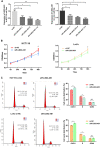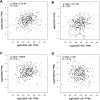Overexpression of Long Noncoding RNA LBX2-AS1 Promotes the Proliferation of Colorectal Cancer
- PMID: 33733923
- PMCID: PMC7983235
- DOI: 10.1177/1533033821997829
Overexpression of Long Noncoding RNA LBX2-AS1 Promotes the Proliferation of Colorectal Cancer
Abstract
Background: LBX2 antisense RNA 1 (LBX2-AS1), a long noncoding RNA, has been identified to be closely associated with the progression of various cancers. However, the role of LBX2-AS1 in colorectal cancer (CRC) is still poorly understood. In this study, we aimed to investigate the expression and function of LBX2-AS1 in CRC.
Material and methods: Expression data from the Gene Expression Omnibus (GEO) and Gene Expression Profiling Interactive Analysis (GEPIA) databases and results obtained from clinical samples/patients were used to determine the correlation between LBX2-AS1 expression and pathological stages, overall survival (OS). Furthermore, knockdown of LBX2-AS1 in CRC cells using the short interfering RNA (siRNA) technique, and observed its biological functions using western blotting, quantitative reverse transcription-polymerase chain reaction (qRT-PCR), cell counting kit-8 (CCK-8) and flow cytometry assay in the CRC cell line.
Results: Our study demonstrated that the expression levels of LBX2-AS1 were higher in CRC cell lines than in normal colon mucosal cell lines. Bioinformatics analysis revealed that CRC patients with high LBX2-AS1 expression levels had poor OS. Furthermore, knockdown of LBX2-AS1 in CRC cells could attenuate the proliferative ability of CRC cells in vitro, which is associated with decreased expression of cyclin-dependent kinase (CDK) 3, CDK6, and CCND1 and enhanced expression of cyclin-dependent kinase inhibitor 1A.
Conclusions: LBX2-AS1 plays a crucial role in the tumorigenesis of CRC, providing a potential therapeutic target for CRC patients.
Keywords: LBX2 antisense RNA 1; colorectal cancer; long noncoding RNA; prognosis; therapy.
Conflict of interest statement
Figures





Similar articles
-
The role of LncRNA LBX2-AS1 in cancers: functions, mechanisms and potential clinical utility.Clin Transl Oncol. 2023 Feb;25(2):293-305. doi: 10.1007/s12094-022-02944-2. Epub 2022 Sep 21. Clin Transl Oncol. 2023. PMID: 36131071 Free PMC article. Review.
-
Long noncoding RNA LBX2-AS1 promotes colorectal cancer progression via binding with PTBP1 and stabilizing KAT2A expression.J Biochem Mol Toxicol. 2022 May;36(5):e23020. doi: 10.1002/jbt.23020. Epub 2022 Mar 7. J Biochem Mol Toxicol. 2022. PMID: 35253306
-
Long Noncoding RNA HOXD-AS1 Promotes the Proliferation, Migration, and Invasion of Colorectal Cancer via the miR-526b-3p/CCND1 Axis.J Surg Res. 2020 Nov;255:525-535. doi: 10.1016/j.jss.2020.05.078. Epub 2020 Jul 5. J Surg Res. 2020. PMID: 32640404
-
Novel long non-coding RNA LBX2-AS1 indicates poor prognosis and promotes cell proliferation and metastasis through Notch signaling in non-small cell lung cancer.Eur Rev Med Pharmacol Sci. 2019 Sep;23(17):7419-7429. doi: 10.26355/eurrev_201909_18851. Eur Rev Med Pharmacol Sci. 2019. PMID: 31539129
-
Long Non-Coding RNA SH3PXD2A-AS1 Promotes Cell Progression Partly Through Epigenetic Silencing P57 and KLF2 in Colorectal Cancer.Cell Physiol Biochem. 2018;46(6):2197-2214. doi: 10.1159/000489589. Epub 2018 May 3. Cell Physiol Biochem. 2018. PMID: 29734178
Cited by
-
LBX2-AS1 Activates FSTL3 by Binding to Transcription Factor RARα to Foster Proliferation, Migration, and Invasion of Thyroid Cancer.Front Genet. 2021 Nov 11;12:765033. doi: 10.3389/fgene.2021.765033. eCollection 2021. Front Genet. 2021. PMID: 34858481 Free PMC article.
-
The role of LncRNA LBX2-AS1 in cancers: functions, mechanisms and potential clinical utility.Clin Transl Oncol. 2023 Feb;25(2):293-305. doi: 10.1007/s12094-022-02944-2. Epub 2022 Sep 21. Clin Transl Oncol. 2023. PMID: 36131071 Free PMC article. Review.
References
-
- Siegel RL, Miller KD, Jemal A. Cancer statistics, 2020. CA Cancer J Clin. 2020;70(1):7–30. - PubMed
-
- Obuch JC, Ahnen DJ. Colorectal cancer: genetics is changing everything. Gastroenterol Clin North Am. 2016;45(3):459–476. - PubMed
-
- Ferlay J, Shin HR, Bray F, Forman D, Mathers C, Parkin DM. Estimates of worldwide burden of cancer in 2008: GLOBOCAN 2008. Int J Cancer. 2010;127(12):2893–2917. - PubMed
Publication types
MeSH terms
Substances
LinkOut - more resources
Full Text Sources
Other Literature Sources
Research Materials

